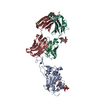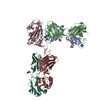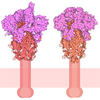[English] 日本語
 Yorodumi
Yorodumi- PDB-8cwk: Fab arm of antibodies 4G1-C2 and 10G4 bound to CoV-2 receptor bin... -
+ Open data
Open data
- Basic information
Basic information
| Entry | Database: PDB / ID: 8cwk | ||||||
|---|---|---|---|---|---|---|---|
| Title | Fab arm of antibodies 4G1-C2 and 10G4 bound to CoV-2 receptor binding domain (RBD) | ||||||
 Components Components |
| ||||||
 Keywords Keywords | IMMUNE SYSTEM / antibody / CoV-2 / receptor binding domain / class 5 epitope | ||||||
| Function / homology |  Function and homology information Function and homology informationimmunoglobulin complex / symbiont-mediated disruption of host tissue / Maturation of spike protein / Translation of Structural Proteins / Virion Assembly and Release / host cell surface / viral translation / host extracellular space / symbiont-mediated-mediated suppression of host tetherin activity / Induction of Cell-Cell Fusion ...immunoglobulin complex / symbiont-mediated disruption of host tissue / Maturation of spike protein / Translation of Structural Proteins / Virion Assembly and Release / host cell surface / viral translation / host extracellular space / symbiont-mediated-mediated suppression of host tetherin activity / Induction of Cell-Cell Fusion / structural constituent of virion / adaptive immune response / membrane fusion / entry receptor-mediated virion attachment to host cell / Attachment and Entry / host cell endoplasmic reticulum-Golgi intermediate compartment membrane / positive regulation of viral entry into host cell / receptor-mediated virion attachment to host cell / host cell surface receptor binding / symbiont-mediated suppression of host innate immune response / receptor ligand activity / endocytosis involved in viral entry into host cell / fusion of virus membrane with host plasma membrane / fusion of virus membrane with host endosome membrane / viral envelope / symbiont entry into host cell / virion attachment to host cell / SARS-CoV-2 activates/modulates innate and adaptive immune responses / host cell plasma membrane / virion membrane / extracellular region / identical protein binding / membrane / plasma membrane Similarity search - Function | ||||||
| Biological species |  Homo sapiens (human) Homo sapiens (human) | ||||||
| Method |  X-RAY DIFFRACTION / X-RAY DIFFRACTION /  SYNCHROTRON / SYNCHROTRON /  MOLECULAR REPLACEMENT / MOLECULAR REPLACEMENT /  molecular replacement / Resolution: 2.368 Å molecular replacement / Resolution: 2.368 Å | ||||||
 Authors Authors | Langley, D.B. / Christ, D. | ||||||
| Funding support |  Australia, 1items Australia, 1items
| ||||||
 Citation Citation |  Journal: Proc Natl Acad Sci U S A / Year: 2025 Journal: Proc Natl Acad Sci U S A / Year: 2025Title: Affinity maturation endows potent activity onto class 6 SARS-CoV-2 broadly neutralizing antibodies. Authors: Ohan Mazigi / David B Langley / Jake Y Henry / Deborah L Burnett / Meghna Sobti / Gregory J Walker / Romain Rouet / Harikrishnan Balachandran / Helen Lenthall / Jennifer Jackson / Stephanie ...Authors: Ohan Mazigi / David B Langley / Jake Y Henry / Deborah L Burnett / Meghna Sobti / Gregory J Walker / Romain Rouet / Harikrishnan Balachandran / Helen Lenthall / Jennifer Jackson / Stephanie Ubiparipovic / Peter Schofield / Simon H J Brown / Sebastian R Schulz / Markus Hoffmann / Stefan Pöhlmann / Jeffrey Post / Marianne Martinello / Golo Ahlenstiel / Anthony Kelleher / William D Rawlinson / Stuart G Turville / Rowena A Bull / Alastair G Stewart / Hans-Martin Jäck / Christopher C Goodnow / Daniel Christ /   Abstract: The emergence of SARS-CoV-2 variants of concern (VOCs) has greatly diminished the neutralizing activity of previously FDA-approved monoclonal antibodies (mAbs), including that of antibody cocktails ...The emergence of SARS-CoV-2 variants of concern (VOCs) has greatly diminished the neutralizing activity of previously FDA-approved monoclonal antibodies (mAbs), including that of antibody cocktails and of first-generation broadly neutralizing antibodies such as S309 (Sotrovimab). In contrast, antibodies targeting cryptic conformational epitopes of the receptor binding domain (RBD) have demonstrated broad activity against emerging variants, but exert only moderate neutralizing activity, which has so far hindered clinical development. Here, we utilize in vitro display technology to identify and affinity-mature antibodies targeting the cryptic class 6 epitope, accessible only in the "up" conformation of the SARS-CoV-2 spike trimer. Increasing antibody affinity into the low picomolar range endowed potent neutralization of VOCs and protection of hACE2 mice from viral challenge. Cryoelectron microscopy and crystal structures of two affinity-matured antibodies (4C12-B12 and 4G1-C2) in complex with RBD highlighted binding modes and epitopes distal from mutational hotspots commonly overserved in VOCs, providing direct structural insights into the observed mutational resistance. Moreover, we further demonstrate that antibodies targeting the class 6 epitope, rather than being an artifact of in vitro selection, are common in the IgG1 memory B cell repertoire of convalescent patients and can be induced in human antibody V-gene transgenic mice through immunization. Our results highlight the importance of very high (picomolar) affinity in the development of neutralizing antibodies and vaccines and suggest an affinity threshold in the provision of broad and long-lasting immunity against SARS-CoV-2. | ||||||
| History |
|
- Structure visualization
Structure visualization
| Structure viewer | Molecule:  Molmil Molmil Jmol/JSmol Jmol/JSmol |
|---|
- Downloads & links
Downloads & links
- Download
Download
| PDBx/mmCIF format |  8cwk.cif.gz 8cwk.cif.gz | 427.6 KB | Display |  PDBx/mmCIF format PDBx/mmCIF format |
|---|---|---|---|---|
| PDB format |  pdb8cwk.ent.gz pdb8cwk.ent.gz | 346.6 KB | Display |  PDB format PDB format |
| PDBx/mmJSON format |  8cwk.json.gz 8cwk.json.gz | Tree view |  PDBx/mmJSON format PDBx/mmJSON format | |
| Others |  Other downloads Other downloads |
-Validation report
| Summary document |  8cwk_validation.pdf.gz 8cwk_validation.pdf.gz | 493.3 KB | Display |  wwPDB validaton report wwPDB validaton report |
|---|---|---|---|---|
| Full document |  8cwk_full_validation.pdf.gz 8cwk_full_validation.pdf.gz | 499.5 KB | Display | |
| Data in XML |  8cwk_validation.xml.gz 8cwk_validation.xml.gz | 39.1 KB | Display | |
| Data in CIF |  8cwk_validation.cif.gz 8cwk_validation.cif.gz | 54.7 KB | Display | |
| Arichive directory |  https://data.pdbj.org/pub/pdb/validation_reports/cw/8cwk https://data.pdbj.org/pub/pdb/validation_reports/cw/8cwk ftp://data.pdbj.org/pub/pdb/validation_reports/cw/8cwk ftp://data.pdbj.org/pub/pdb/validation_reports/cw/8cwk | HTTPS FTP |
-Related structure data
| Related structure data |  8cwiC  8cwjC C: citing same article ( |
|---|---|
| Similar structure data | Similarity search - Function & homology  F&H Search F&H Search |
- Links
Links
- Assembly
Assembly
| Deposited unit | 
| ||||||||
|---|---|---|---|---|---|---|---|---|---|
| 1 |
| ||||||||
| Unit cell |
|
- Components
Components
-Antibody , 4 types, 4 molecules HLAB
| #1: Antibody | Mass: 24475.314 Da / Num. of mol.: 1 Source method: isolated from a genetically manipulated source Source: (gene. exp.)  Homo sapiens (human) / Cell line (production host): ExpiCHO / Production host: Homo sapiens (human) / Cell line (production host): ExpiCHO / Production host:  |
|---|---|
| #2: Antibody | Mass: 23591.232 Da / Num. of mol.: 1 Source method: isolated from a genetically manipulated source Source: (gene. exp.)  Homo sapiens (human) / Cell line (production host): ExpiCHO / Production host: Homo sapiens (human) / Cell line (production host): ExpiCHO / Production host:  |
| #3: Antibody | Mass: 24809.555 Da / Num. of mol.: 1 Source method: isolated from a genetically manipulated source Source: (gene. exp.)  Homo sapiens (human) / Cell line (production host): ExpiCHO / Production host: Homo sapiens (human) / Cell line (production host): ExpiCHO / Production host:  |
| #4: Antibody | Mass: 23614.150 Da / Num. of mol.: 1 Source method: isolated from a genetically manipulated source Source: (gene. exp.)  Homo sapiens (human) / Cell line (production host): ExpiCHO / Production host: Homo sapiens (human) / Cell line (production host): ExpiCHO / Production host:  |
-Protein / Sugars , 2 types, 3 molecules C

| #5: Protein | Mass: 22975.688 Da / Num. of mol.: 1 / Fragment: receptor binding domain (RBD) Source method: isolated from a genetically manipulated source Source: (gene. exp.)  Gene: S, 2 / Cell line (production host): ExpiCHO / Production host:  |
|---|---|
| #7: Sugar |
-Non-polymers , 2 types, 183 molecules 


| #6: Chemical | ChemComp-GOL / #8: Water | ChemComp-HOH / | |
|---|
-Details
| Has ligand of interest | N |
|---|---|
| Has protein modification | Y |
-Experimental details
-Experiment
| Experiment | Method:  X-RAY DIFFRACTION / Number of used crystals: 1 X-RAY DIFFRACTION / Number of used crystals: 1 |
|---|
- Sample preparation
Sample preparation
| Crystal | Density Matthews: 3.27 Å3/Da / Density % sol: 62.42 % |
|---|---|
| Crystal grow | Temperature: 293 K / Method: vapor diffusion, hanging drop Details: Equal volume (2 uL) of protein solution (approx 5 mg/mL, in 25 mM Tris (pH 8.0), 200 mM NaCl) was mixed with an equal volume of well solution comprising 200 mM sodium citrate, 100 mM Bis- ...Details: Equal volume (2 uL) of protein solution (approx 5 mg/mL, in 25 mM Tris (pH 8.0), 200 mM NaCl) was mixed with an equal volume of well solution comprising 200 mM sodium citrate, 100 mM Bis-Tris-Propane (pH 7.4), 18% PEG3350). For cryoprotection the crystal was swum briefly (5-10 sec) in well solution doped with glycerol to a final concentration of ~25%. |
-Data collection
| Diffraction | Mean temperature: 100 K / Serial crystal experiment: N | |||||||||||||||||||||||||||
|---|---|---|---|---|---|---|---|---|---|---|---|---|---|---|---|---|---|---|---|---|---|---|---|---|---|---|---|---|
| Diffraction source | Source:  SYNCHROTRON / Site: SYNCHROTRON / Site:  Australian Synchrotron Australian Synchrotron  / Beamline: MX2 / Wavelength: 0.9536 Å / Beamline: MX2 / Wavelength: 0.9536 Å | |||||||||||||||||||||||||||
| Detector | Type: DECTRIS EIGER X 16M / Detector: PIXEL / Date: Oct 21, 2021 | |||||||||||||||||||||||||||
| Radiation | Protocol: SINGLE WAVELENGTH / Monochromatic (M) / Laue (L): M / Scattering type: x-ray | |||||||||||||||||||||||||||
| Radiation wavelength | Wavelength: 0.9536 Å / Relative weight: 1 | |||||||||||||||||||||||||||
| Reflection | Resolution: 2.368→45.8 Å / Num. obs: 62334 / % possible obs: 99.3 % / Redundancy: 5.9 % / Biso Wilson estimate: 53.77 Å2 / CC1/2: 0.997 / Rmerge(I) obs: 0.092 / Rpim(I) all: 0.041 / Rrim(I) all: 0.101 / Net I/σ(I): 10.9 | |||||||||||||||||||||||||||
| Reflection shell | Diffraction-ID: 1 / Redundancy: 5.8 %
|
-Phasing
| Phasing | Method:  molecular replacement molecular replacement | |||||||||
|---|---|---|---|---|---|---|---|---|---|---|
| Phasing MR | Model details: Phaser MODE: MR_AUTO
|
- Processing
Processing
| Software |
| ||||||||||||||||||||||||||||||||||||||||||||||||||||||||||||||||||||||||||||||||||||||||||||||||||||||||||||||||||||||||||||||||||||||||||
|---|---|---|---|---|---|---|---|---|---|---|---|---|---|---|---|---|---|---|---|---|---|---|---|---|---|---|---|---|---|---|---|---|---|---|---|---|---|---|---|---|---|---|---|---|---|---|---|---|---|---|---|---|---|---|---|---|---|---|---|---|---|---|---|---|---|---|---|---|---|---|---|---|---|---|---|---|---|---|---|---|---|---|---|---|---|---|---|---|---|---|---|---|---|---|---|---|---|---|---|---|---|---|---|---|---|---|---|---|---|---|---|---|---|---|---|---|---|---|---|---|---|---|---|---|---|---|---|---|---|---|---|---|---|---|---|---|---|---|---|
| Refinement | Method to determine structure:  MOLECULAR REPLACEMENT MOLECULAR REPLACEMENTStarting model: generic Fab and RBD Resolution: 2.368→43.235 Å / SU ML: 0.33 / Cross valid method: THROUGHOUT / σ(F): 1.34 / Phase error: 25.98 / Stereochemistry target values: ML
| ||||||||||||||||||||||||||||||||||||||||||||||||||||||||||||||||||||||||||||||||||||||||||||||||||||||||||||||||||||||||||||||||||||||||||
| Solvent computation | Shrinkage radii: 0.9 Å / VDW probe radii: 1.11 Å / Solvent model: FLAT BULK SOLVENT MODEL | ||||||||||||||||||||||||||||||||||||||||||||||||||||||||||||||||||||||||||||||||||||||||||||||||||||||||||||||||||||||||||||||||||||||||||
| Displacement parameters | Biso max: 139.78 Å2 / Biso mean: 58.7074 Å2 / Biso min: 29.59 Å2 | ||||||||||||||||||||||||||||||||||||||||||||||||||||||||||||||||||||||||||||||||||||||||||||||||||||||||||||||||||||||||||||||||||||||||||
| Refinement step | Cycle: final / Resolution: 2.368→43.235 Å
| ||||||||||||||||||||||||||||||||||||||||||||||||||||||||||||||||||||||||||||||||||||||||||||||||||||||||||||||||||||||||||||||||||||||||||
| Refine LS restraints |
| ||||||||||||||||||||||||||||||||||||||||||||||||||||||||||||||||||||||||||||||||||||||||||||||||||||||||||||||||||||||||||||||||||||||||||
| LS refinement shell | Refine-ID: X-RAY DIFFRACTION / Rfactor Rfree error: 0
| ||||||||||||||||||||||||||||||||||||||||||||||||||||||||||||||||||||||||||||||||||||||||||||||||||||||||||||||||||||||||||||||||||||||||||
| Refinement TLS params. | Method: refined / Origin x: 2.708 Å / Origin y: 41.2579 Å / Origin z: 76.4311 Å
| ||||||||||||||||||||||||||||||||||||||||||||||||||||||||||||||||||||||||||||||||||||||||||||||||||||||||||||||||||||||||||||||||||||||||||
| Refinement TLS group |
|
 Movie
Movie Controller
Controller



 PDBj
PDBj






